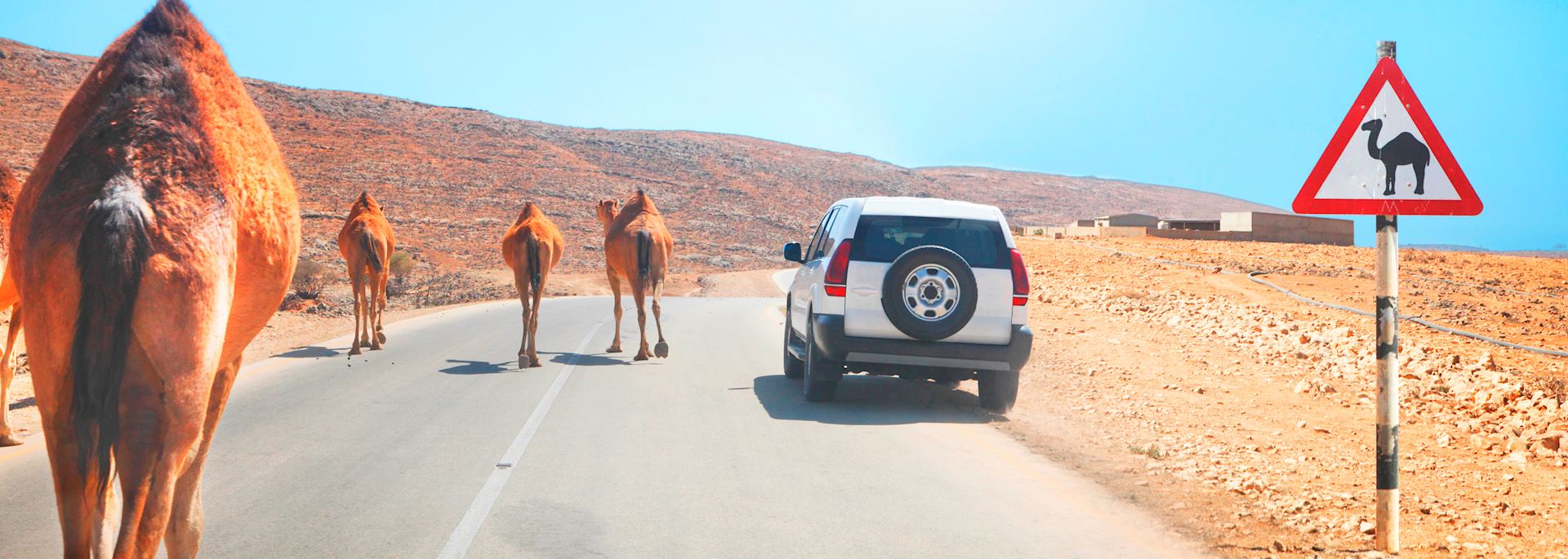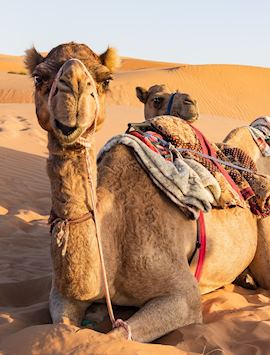By specialist Paula
Are you thrilled at the idea of driving through a nigh-trackless desert? Do you delight in the prospect of navigating rugged mountains to find sweeping vistas where you’re the only one in sight? If so, I suggest self-driving in Oman is for you.
Because it’s not freighted with blockbuster sights like the pyramids or Petra, Oman is gloriously free of crowds, which makes it a good option for an adventurous week long self-drive trip. Driving yourself also means you can take your time and experience the country viscerally, without the interpretation of a private guide.
A cruise and market visit in Muscat
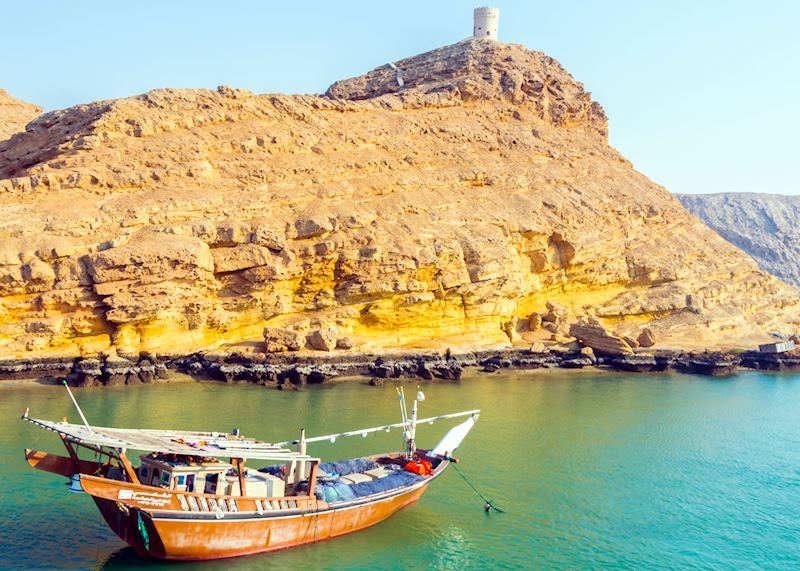
Though it’s perched right on the coast of the Arabian Sea, Muscat hasn’t succumbed to high-rise resorts. Thanks to thoughtful development, the city retains an old-fashioned elegance, with white buildings, pristine beaches and a low skyline punctuated by onion domes and minarets. You don’t need to drive during your stay in Muscat, but it’s a good place to recover from your flight before you pick up your car.
A good way for you to take in the whole length of the city, which stretches out along the shoreline, is a sunset cruise in a dhow. These traditional wooden boats have a wide hull and intricate carvings on the exterior. I like the wind and sun in my face, so I chose a seat on the main deck, but there was a covered upper deck if you prefer a bit of shade.
Southeast of the city the buildings dwindled, and the coast was dominated by imposing, bare-sloped mountains. As I gazed at the landscape, the crew served snacks, including a tray of dried dates and Omani coffee. It was my first experience of the dark, fragrant drink — it’s as strong as most Arab coffee, but the Omanis make it with rosewater, the floral sweetness helping to balance the bracing brew.
The boat returned to dock just as the sun was sinking behind the buildings and the fading light threw the mountains into sharp relief, providing a dark backdrop for the twinkling lights of the city.
The next morning, I woke up early to visit the city’s enormous Muttrah souq with a guide. This is one of the oldest markets in the Arab world, even though it’s housed in a modern facility. That doesn’t detract from the bright chaos of the souq, however, which is huge and often packed with locals going about their business.
In addition to the usual shops selling food, clothing and other everyday items — easy to find, thanks to the fact that each area is named after the goods sold there — there are several sections that sell high-end items. I was enchanted by the displays of necklaces and headdresses in the gold section.
The Place & People Museum is close to the souq, providing an easy alternative for anyone in your party who’s bored by shopping. Previously called Ghalya's Museum of Modern Art, it’s a small house wrapped around a tiny courtyard and exhibits include displays of historical Omani life as well as contemporary art.
In all, if you haven’t been to Muscat before, I suggest spending two or three days here, to also explore the enormous Sultan Qaboos Grand Mosque and the historic forts, either on a guided city tour or on your own.
Endless golden dunes in the Wahiba Sands
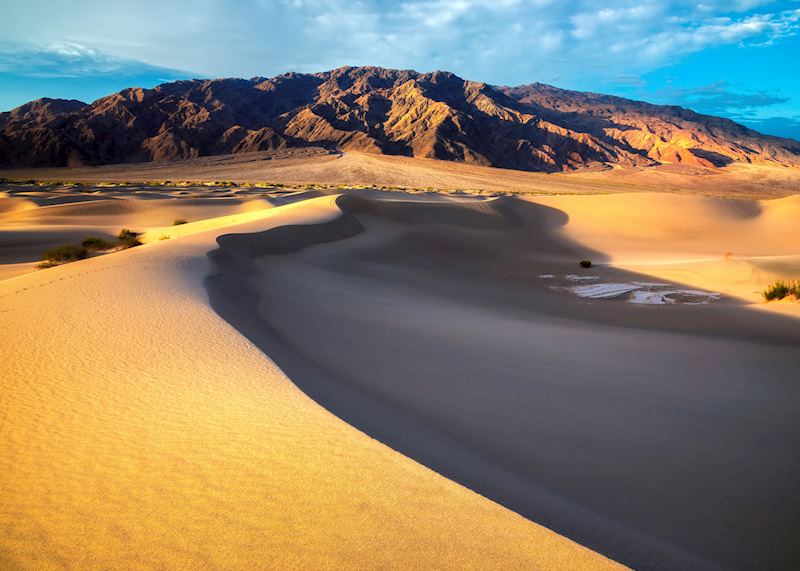
After recovering from your flight in the urban comforts of Muscat, pick up your car for the first leg of your adventure: the Wahiba Sands.
The drive to your desert camp takes about three hours and most of the trip is on well-marked, paved roads through stony scrubland, passing stands of feathery palms and sunbaked small towns. But, following our detailed directions, you’ll eventually reach a tiny nameless cluster of buildings that’s comprised mostly of shops that service tires.
You’ll have to pull into one of these to have some of the air let out of your tires, an imperative step on the next part of your journey as the slightly deflated tires will help you stay on top of the soft sand. Continue a bit further until the paved road abruptly stops at the edge of a vast and rolling sea of golden sand dunes. You’ve reached the Wahiba Sands.
There are no roads and no signs, just a single set of tire tracks dwindling into the distance. As the journey into the desert can be a little daunting, the camp provide an escort service and follow car, so after meeting up on the edge of the sands we were ready to follow our escort into the vast sea of dunes.
I must admit I found it slightly unnerving as I drove deeper and deeper into the blazing wasteland. Some of the dunes tower up to (24 m) 80 ft tall and I was certainly grateful to have someone to follow.
After just under an hour, we finally came upon our destination — 1,000 Nights Desert Camp. With an outdoor dining area and even a swimming pool, it’s a comfortable base for exploring the desert and you can indulge in any number of activities, from riding on a camel to dune-bashing.
Goats and souqs in Nizwa
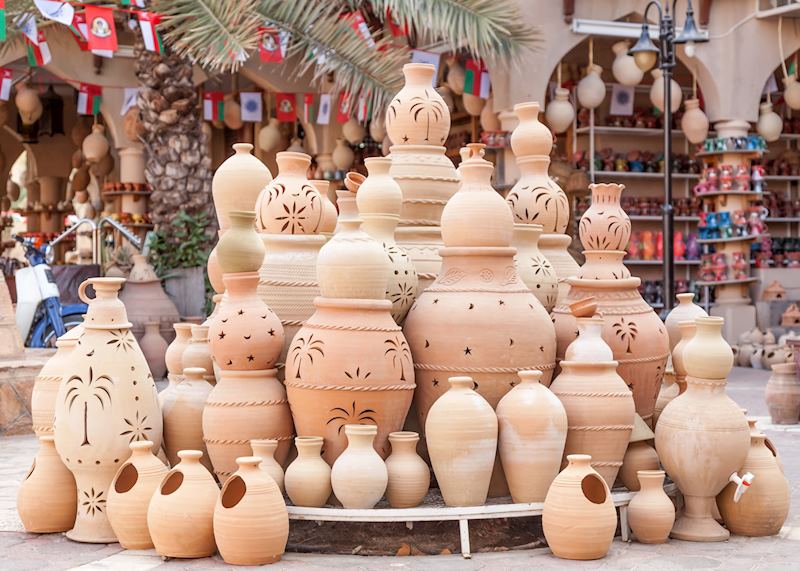
Driving out of the desert is a jolt. The dunes seem so timeless and endless that the sudden reappearance of civilization, even if it’s in the form of a sand-blown paved road, can be a bit surreal. I drove back to the same place that had deflated my tires and got them back up to regulation pressure before heading northwest to Nizwa, just under three hours to the northwest.
I suggest timing your visit so it falls on a Friday morning, to watch the livestock market. Sellers bring in their animals, mostly goats and cows, and walk them around in a circle, and buyers inspect the animals carefully.
If the seller likes what he sees (it’s always men), there’s some bargaining, money changes hands and then the goat is led off with its new owner. The only thing that has changed over the long years is the way that animals arrive — today, they’re likely to be brought in a pick-up truck rather than on foot.
The market is held just outside of the souq, which is one of the oldest in the country. In addition to the usual things — fruit and vegetables, meat and fish, clothing and pottery — you’ll also find some less-common options, like the pet souq, where locals buy everything from hamsters and rabbits to tropical birds.
The silver souq is impressive, too. Nizwa smiths are renowned for their skills, and you’ll find a wide selection here. Necklaces and other baubles are sold by weight, so it’s considered bad form to haggle.
Villages and views in the Al Hajar Mountains
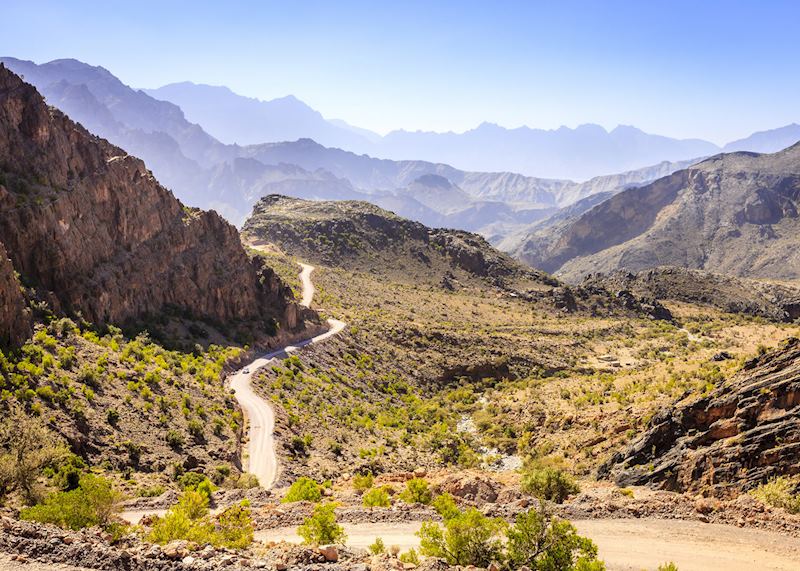
Very few trees or bushes soften the line of the Al Hajar Mountains, which are located just outside of Nizwa, and driving into the mountains is probably the most challenging leg of a self-drive trip to Oman. The winding roads don’t always have guard rails and are sometimes too narrow to pass another car, which can result in complicated jockeying if you come upon another driver going in the opposite direction.
That said, the views are entirely worth the effort.
My first stop was Jebel Akhdar, which you can visit as a day trip from Nizwa. However, I wanted to really soak up the views so chose to stay the night at Alila Jabal Akhdar, an indulgent hotel perched near the mountain’s peak. Made from stone, it seemed perfectly at home among the rocky mountain terrain, and all the rooms boast sweeping views over the mountains.
From the peak of Jebel Akhdar, it’s a two-hour drive down and then back up to the peak of Jebel Shams, the range’s highest mountain. Along the way, you can stop and wander through small villages that nestle in the green valleys or cling to the sheer cliffs.
But the reason to visit, for me, was to see Wadi Ghul, often called the Omani Grand Canyon. As it’s the second-largest canyon in the world I expected it to be crowded, but I was the only one there. The views are primal and sweeping, encompassing bare-stone mountains, distant peaks and a massive, steep drop that’s almost 1,000 m (3,280 ft) in places. Gazing over the raw cliff edge, I felt like I was alone on the top of the world.
Read more about self-drive trips to Oman
Start thinking about your experience. These itineraries are simply suggestions for how you could enjoy some of the same experiences as our specialists. They're just for inspiration, because your trip will be created around your particular tastes.
View All Tours in Oman